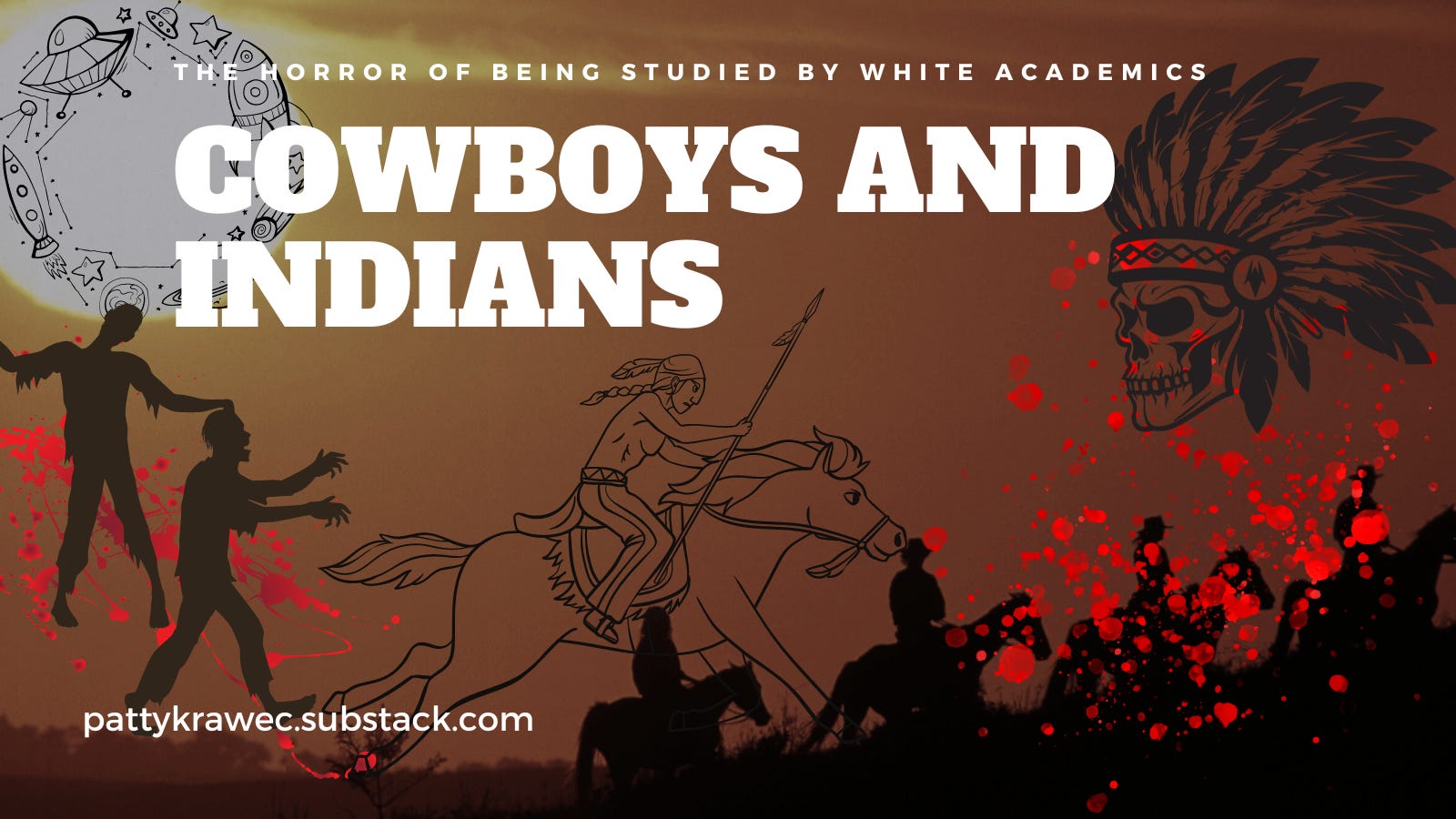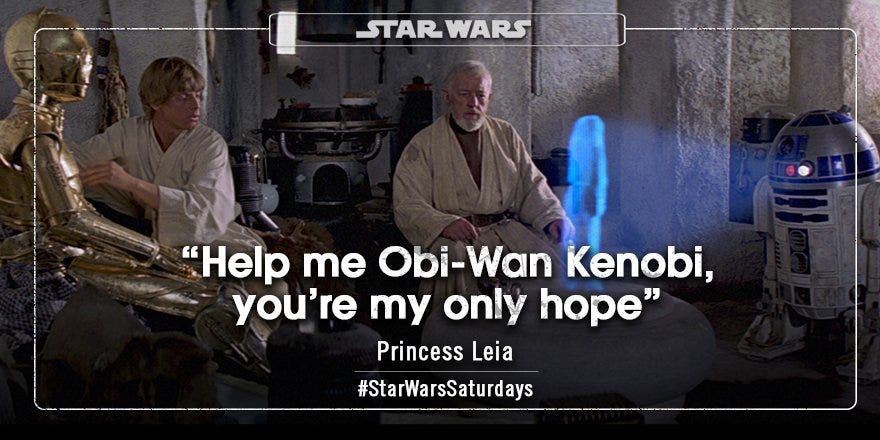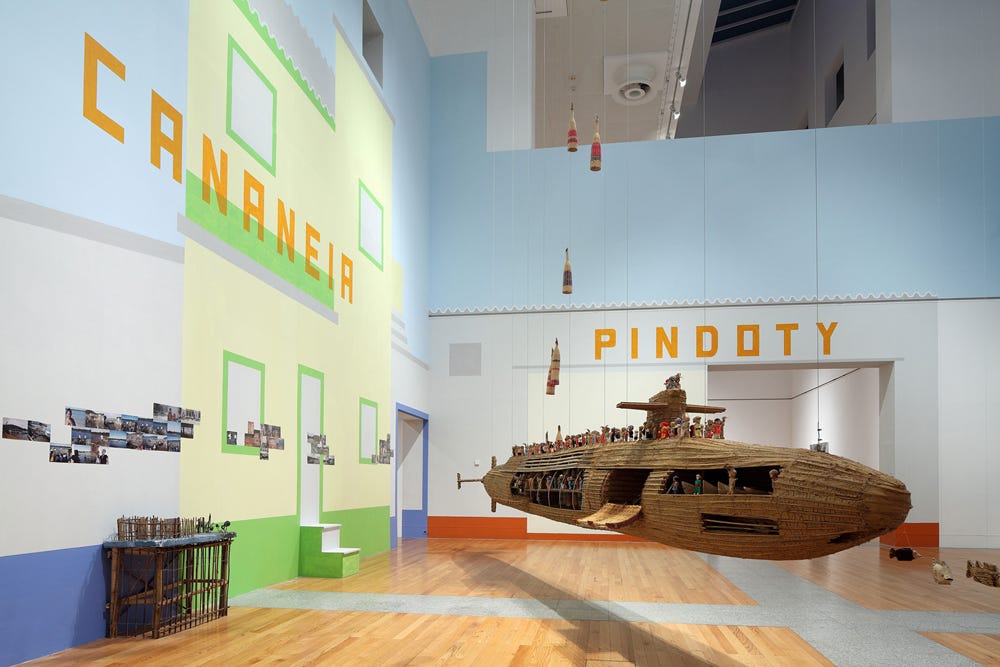cowboys and indians
The horror of being studied by white academics

An interesting thing happened at the NAISA conference in early May. There were two sessions on horror, back to back. One on Indigenous presence in white produced horror, the other on Indigenous produced horror. What was interesting was that the first session, looking for Indigenous presence, was lead by two Indigenous academics and the second session, analyizing Indigenous horror, was lead by settler academics which to be completely frank, just made me tired and I considered leaving. These white women were all looking for answers of some kind. The decolonizing potential of Native American horror. Worldbuilding. Horror as a place to tease out border possibilities. Kali Simmons and Shaawano Uban were also looking for answers I suppose, answers to the violence inherent in settler identity. It was interesting (that word again) to me that the white academics were looking for decolonial narratives and the Indigenous academics just wanted the killing to stop. The juxtaposition of these two conversations was intriguing so I stayed.

“The smuggling of coloniality beneath the guise of radicalism”
Shaawano Uran
In his book, Local Histories/Global Designs, which I’ve written about before, Walter Mignolo writes about border thinking. Shifting away from the colonization of time and place and towards the places where instead of insisting on borders and hard lines we live in the changing and complicated gradients of lived relationship. So isn’t what these white academics are doing exactly what they should be doing? Don’t we want them looking towards Indigenous stories rather than continuing to center white narratives?
Maybe?
But it still felt off.
In his presentation Uran made a remark in the context of the punk scene, the appropriation of a primitive other as a way to push back against coloniality, against capitalism. From the mohawk hairstyle to the sound itself, punk has an appropriation problem that has uncritically taken what wasn’t theirs in order to criticize power. They definitely aren’t the first to go beyond colonial borders looking for some mythic past to give their lives meaning, some pure way of being that can be reclaimed or repurposed. Sharpen somebody else’s glorious past into spikes for your cuff but you can’t tear down the master’s house with the master’s tools and you won’t find salvation from within the things you need saving from. Colonialism is still colonialism even if it is, as Uran pointed out, smuggled in under the guise of radicalism.
And we flocked to it anyway. I know a lot of (aging) Native punks who were part of that scene in the 70s and 80s. There was something we heard in the songs, something we saw in the clothing. I was more Thompson Twins and Bruce Springsteen than The Clash, but I heard it too and even imperfect representation is still representation. They may not have seen us fully, but they saw us and that matters right? Unfortunately as Uran pointed out, any push back was pushed back. They didn’t want to hear about what they were doing, they were the rebels and we were what. The advertising copy? The decorations? Listening to these white academics, I wondered if this wasn’t more of the same. Appropriating our stories as a way of pushing back against colonial narratives.
I don’t know these academics, so I can’t say if they have any relationship with the people they are studying, but does that still give them the right to analyze our stories as a solution to their problems? Shouldn’t they be analyzing their own stories for the roots of violence? That’s honestly the best feedback I ever get on my book, by the way, that it prompted somebody to look into their own histories for the answers they were looking for. Pick up your own bundle.
It felt like a move to innocence. There is an expectation among liberals that somehow Indigenous people will fix everything because we’ve held onto traditional knowledge or relationship to land or what have you and that’s awfully rich isn’t it? For a society that spent hundreds of years and billions of dollars trying to destroy us to turn around and expect that we’ll somehow pull something from that wreckage to save you.

In her presentation Kali Simmons drew on Westerns. I hadn’t thought of Westerns as horror, but it makes sense on many levels. She talked specifically about the movie Nick of the Woods, based on a novel by Robert Montgomery Bird written in the early 19th century and contrasted it with work of James Fennimore Cooper who wrote a little earlier. Cooper’s Leatherstocking Tales arguably created the romantic myth of the American frontier, complete with noble savages who just vanish into the past after bestowing a name and birthright, something that Bird felt was ridiculous. For him we were just savages, no nobility at all, and through his writing and the subsequent western genre, Indigenous genocide became entwined with American masculinity. The violence of native people in westerns is presented as intrinsic and inexplicable just as the violence of horror movie villains. The violence of the heroes, even when it is extreme, is understandable and excusable.
As an aside, I love Firefly and the movie Serenity is one of my favourites. There is an extraordinary scene where River, in an attempt to save her brother, takes on a horde of Reavers and her violence is so beautifully choreographed. The actress is a trained dancer so her movements are smooth and graceful, a contrast to the savage Reavers who are, unfortunately, coded as Indigenous. Firefly, like Star Wars, is a space western with cowboys and Indians. Now, this coding of the Reavers as Indigenous is complicated by the revelation that it was the Alliance itself that created them by tinkering with chemicals intended to manufacture a docile society. Is Whedon suggesting that the violence of Indigenous people was something created by colonial activity?
That’s an interesting question. I’ll need to watch that movie again. But was I was thinking about in this was how River’s violence is shown to be self-sacrificing and graceful and the violence of the Reavers is unthinking brutality. But if Whedon is saying that the Alliance created the Reavers, then isn’t their violence now understandable? Their actions become a kind of reaction against the same society that Mal and his malcontents are also fighting against. They’re on the same side aren’t they?
I’ve really digressed and this is not the substack for that. Carrying on.
It would have been interesting to hear the white academics analyzing their own identities and tropes within Indigenous made horror. Where are they in our stories? Interestingly one academic looked at Barnaby’s Blood Quantum in which the future is embodied in the baby of a white woman while the Mi’kmaq man is castrated. Huh. That’s a storyline that needs a lot more unpacking than I have the inclination to do at the moment. This academic didn’t examine it either. She talked about horror being a place where we tease out border possibilities and how we draw boundaries of belonging. Maybe she drew that boundary of belonging around a future embodied in the child of a white woman while the Native man is stopped from procreating at all. Sometimes the future is white even in Indigenous horror.
One panelist was really taken by the Zapatista’s many worlds view, which I’ll admit I am also taken with, and she showed us images of Indigenous people in space. An arts project called the Autonomous Intergalactic Space Program which is pretty cool actually but also .. odd. The project takes space exploration “man’s ultimate frontier” (seriously) from the perspective of Indigenous people. I’m a little puzzled by it, the people curating the project are not Indigenous although the artists themselves are. I mean, it sounds fun and the images are neat but idk. It feels like leapfrogging. Using space exploration to turn away from land and autonomy to some imagined future in which the Indigenous people don’t use metal I guess. We all live in a corncob subspacemarine. The project looks like a performance of reconciliation without really reconciling anything.

It’s that shifting away from land and autonomy that characterized all the white academics. They want a path forward to some shared future with a history left in the past. In her book, Scenes of Subjection, Saidiya Hartman writes that “the repression of history produces national innocence, and blames the victims of that unspoken violence for their condition.” (p235). This is how I felt listening to these white academics looking for hope and absolution in Indigenous horror. It was a kind of repression that produces innocence. No examination of their own place in these films or how they are seen. No examination of their similarity to the punks in the 80s, their colonization of Indigenous story to imagine their own rebellion. No recognition that while they, like Fennimore Cooper, may have had a more flattering view of us, it’s still a colonial view that doesn’t really see us.
Meanwhile, we just want the violence to stop.
